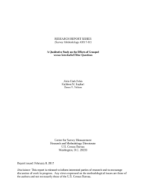
An official website of the United States government
Here’s how you know
Official websites use .gov
A .gov website belongs to an official government organization in the United States.
Secure .gov websites use HTTPS
A lock (
) or https:// means you’ve safely connected to the .gov website. Share sensitive information only on official, secure websites.
-
//
- Census.gov /
- Library /
- Census Working Papers /
- A Study on the Effects of Grouped versus Interleafed
A Qualitative Study on the Effects of Grouped versus Interleafed Filter Questions
A Qualitative Study on the Effects of Grouped versus Interleafed Filter Questions
Abstract
Filter questions are used in many surveys to avoid asking follow-up questions that do not apply to every respondent. Often, detailed follow-up questions are asked immediately after a filter question is endorsed. This design is called interleafing. In contrast, other surveys use a ‘grouped’ approach where several yes/no filter questions are asked first, and the follow-up questions for any filter question that was endorsed are asked later in the survey. Previous research has found that when filter questions are grouped together before follow-up questions, respondents report significantly more “yes” responses than in the traditional interleafed design (Eckman et al. 2014; Kreuter et al. 2011; Duan et al. 2007; Kessler et al. 1998). Literature also suggests that a decrease in the quality of follow-up responses may be a trade-off of the grouped filter question design. Using a subset of sections from the Consumer Expenditure Survey (CE), we conducted a cognitive study on the effects of grouping versus interleafing filter questions. This study provides qualitative data on the trade-offs between grouped and interleafed filter questions in the CE. We present qualitative evidence that the grouped format may increase cognitive burden on respondents and suggest that this is one possible reason for the observed decrease in response quality to follow-up questions in the grouped filter question design.
Others in Series
Working Paper
Working Paper
Working Paper
Share
Related Information
Some content on this site is available in several different electronic formats. Some of the files may require a plug-in or additional software to view.
 Yes
Yes
 No
NoComments or suggestions?


Top

